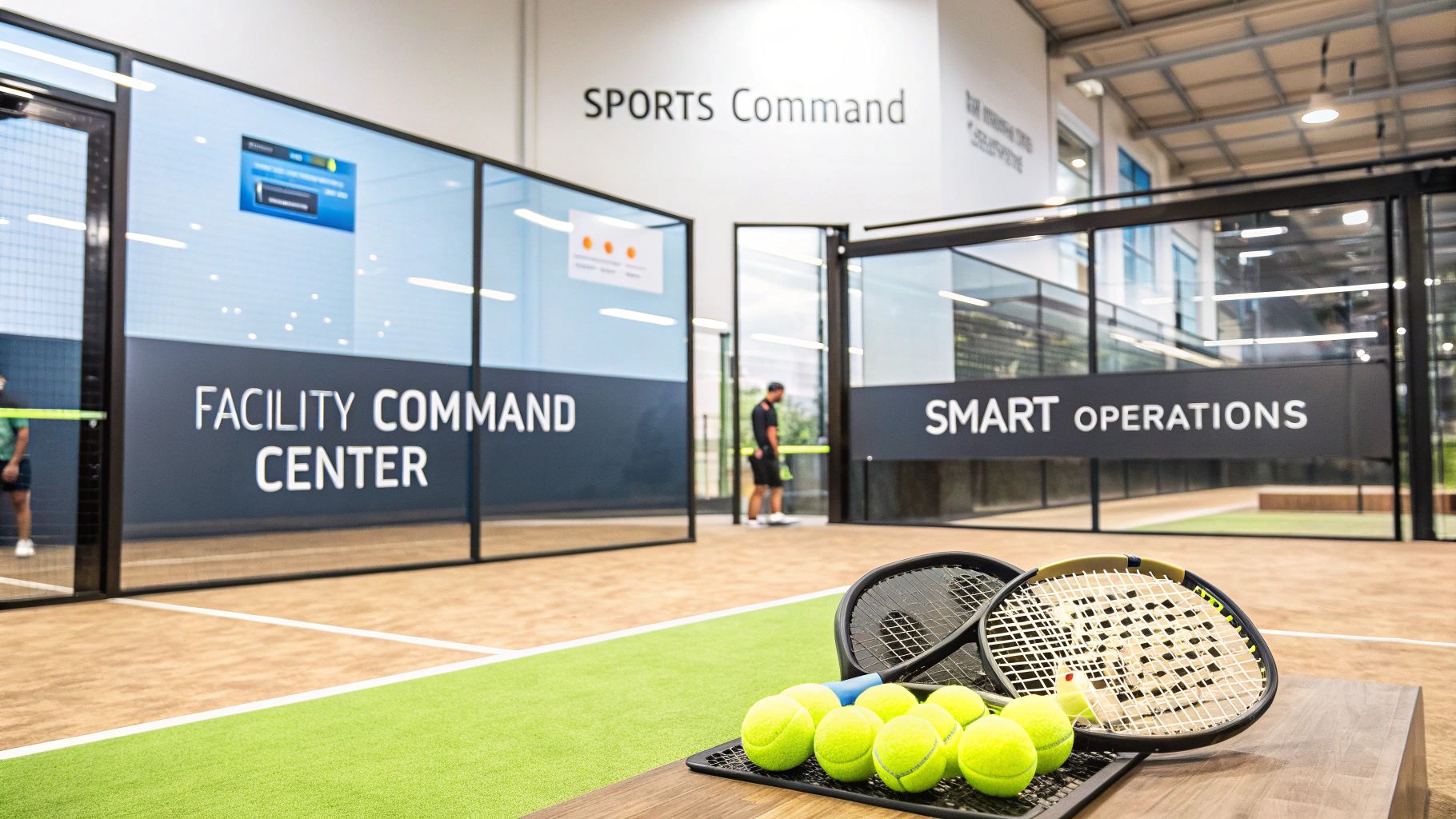Sports facility management software is basically the central command center for venues like padel clubs, stadiums, and local community centers. It’s the engine that automates the really critical stuff—court bookings, membership renewals, and processing payments. This tech essentially kicks old-school methods like spreadsheets and scribbled-on calendars to the curb, replacing them with a single, smart digital system.
How Software Completely Changes the Game for Sports Facilities
Picture your sports complex running with the slick precision of a championship team. Bookings just pop up on your calendar automatically. Member renewals get handled without you picking up the phone once. And maintenance gets scheduled before something breaks. This isn't some far-off dream; it's the reality for clubs using a dedicated management platform.
This is a massive shift away from clunky, disconnected tools. Instead of wrestling with a spreadsheet for your finances, a totally separate calendar for court bookings, and a dusty old notebook for member details, everything lives in one spot. This move instantly makes everything more efficient, keeps your members happy with a super smooth experience, and helps you build predictable revenue.
From Manual Chaos to Automated Control
The real magic here is automation. All those repetitive, soul-crushing tasks that used to eat up your staff's time are now handled effortlessly by the software. This frees up your team to focus on what actually matters—engaging with members, improving the vibe at the club, and making sure everyone has a great time.
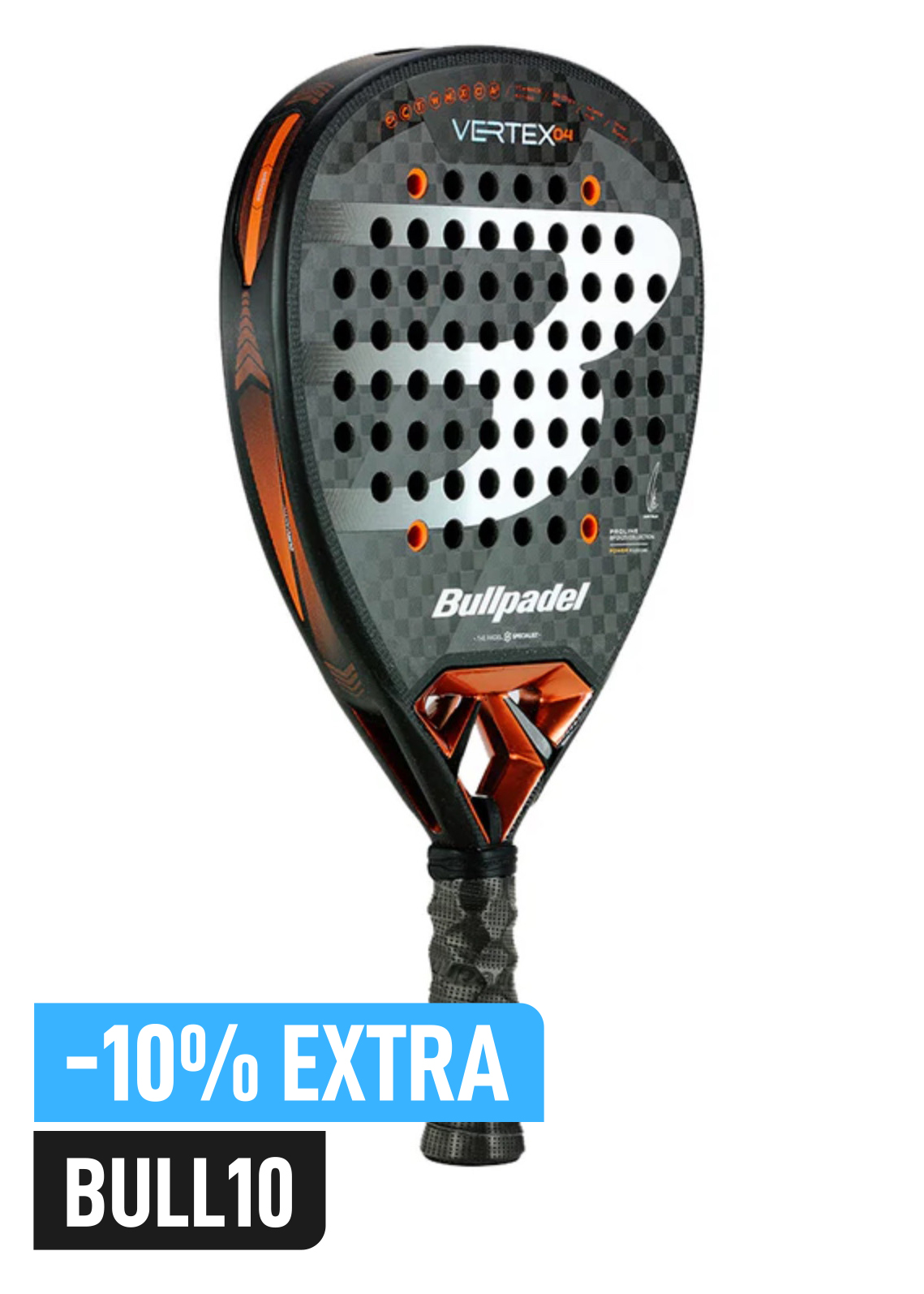
Buy the best padel gear to level up your next game!
CHECK OUT this deal from Padel Market!Get ready to take your game to the next level with the latest padel gear from Padel Market! Fast EU and Worldwide Shipping
But this isn't just about saving a few hours. It fundamentally changes how your facility runs. The market is definitely catching on, too. The global sports facility management software market is sitting at around $2.5 billion and is expected to grow at about 12% a year through 2033. That kind of growth just screams that clubs are desperate for tools that make them run better and keep their customers coming back.
A great software platform doesn't just manage your facility—it optimizes it. It turns raw operational data into real insights, helping you make smarter decisions on everything from court pricing to staffing levels.
Building a Foundation for Growth
Let's be real: having this kind of software isn't a luxury anymore. It’s a core asset for any modern sports facility that wants to do more than just survive. The platform becomes the backbone of your business, supporting every single interaction and transaction.
As the industry gets more competitive—with trends like bigger networks gobbling up smaller players (https://padelrumors.pages.dev/news/matchi-grows-acquires-spanish-competitor/)—having a solid system is what keeps you in the game. To get the most out of your software, it helps to pair it with some solid general facility management best practices. Ultimately, it gives you the structure you need to grow for the long haul by:
- Improving Member Retention: A slick booking and payment process is a small thing that makes a huge difference in keeping members happy.
- Maximizing Revenue: Tools for dynamic pricing and running promotions help you fill those quiet, off-peak hours.
- Enhancing Security and Access: Integrated systems can control who gets onto the courts and when.
- Providing Data-Driven Insights: Analytics show you exactly which courts are the most popular and what your busiest times are, so you can plan accordingly.
Breaking Down the Core Features of Modern Management Software
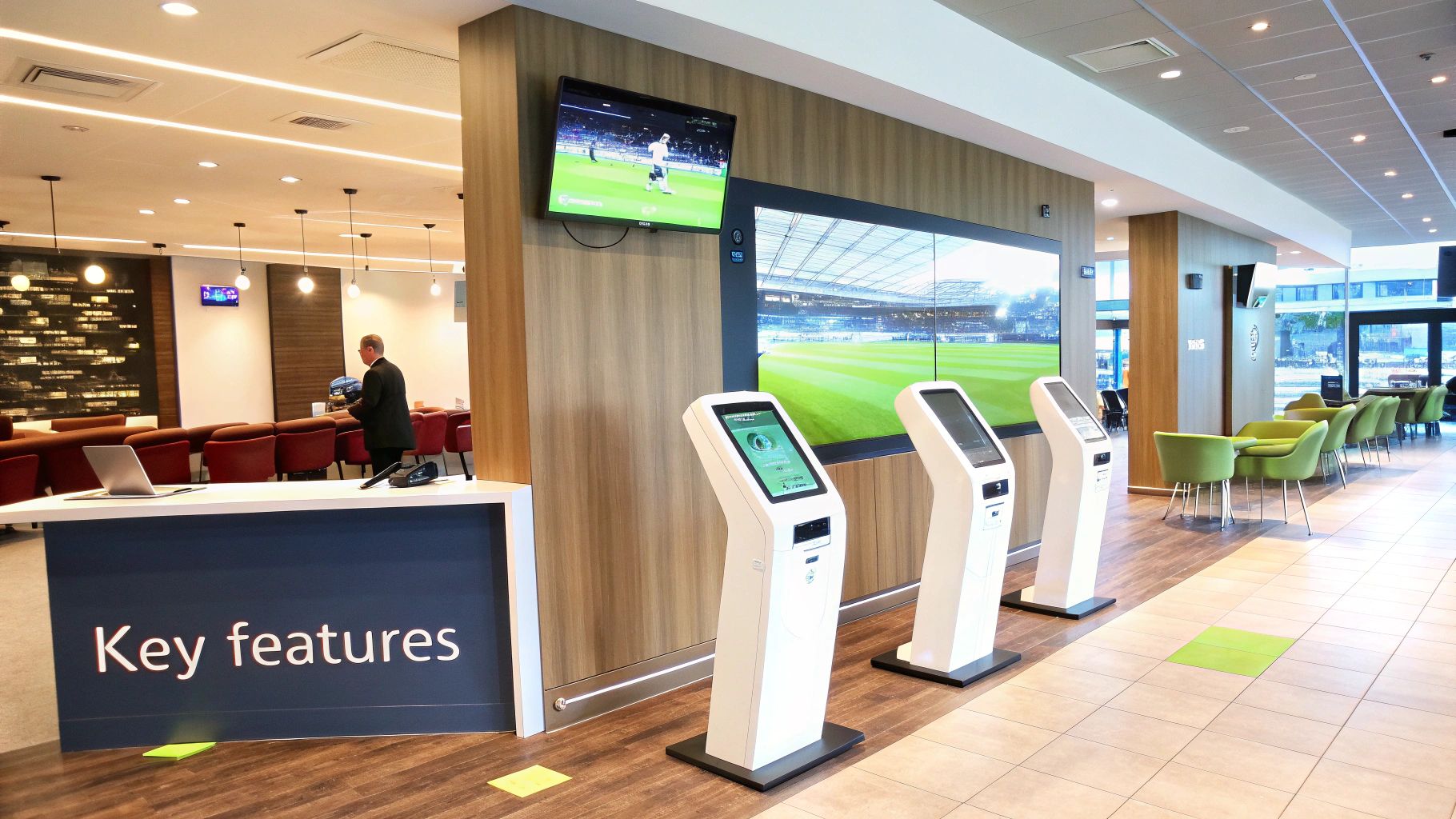
Not all platforms are created equal. Choosing the right sports facility management software feels a lot like picking a co-captain for your business—you need a partner that's reliable, smart, and can handle the daily grind without breaking a sweat. Let's cut through the marketing jargon and get into the core features that actually make a difference.
Think of these features as specialist players on your team. Each has a specific job, but they all need to work together to win. From booking courts to managing memberships, these tools are built to take repetitive tasks off your plate and give everyone a better experience.
This is exactly why cloud-based systems have become the go-to choice. Experts predict these platforms will capture over 65% of the market share by 2026, driven by clubs needing real-time, scalable access to their operations from literally anywhere. You can dive deeper into this trend by checking out the full research on the future of facility management software.
Let's unpack the essential tools you should be looking for.
H3: Online Booking and Scheduling Automation
The schedule is the heart of any sports facility. An automated online booking system isn't just a nice-to-have; it's the absolute centerpiece of any modern software. It puts an end to frustrating phone tag and kills the risk of accidentally double-booking your prime-time padel courts.
Players can see what’s available in real-time, book a slot, and get an instant confirmation right from their phone. This self-service approach doesn't just free up your staff—it delivers the on-demand convenience today's customers expect. The best systems even handle complex rules, like setting different prices for peak hours or creating early booking windows just for members.
H3: Integrated Payment Processing
Getting paid should be simple and secure, not a headache of manual tasks. Integrated payment processing lets you collect fees for everything—court bookings, membership dues, tournament entries, and pro shop sales—all in one place.
This consolidation means no more juggling different payment apps or manually matching up transactions at the end of the day. It cleans up your accounting, slashes errors, and gives members a professional, trustworthy way to pay. Be sure to look for systems that accept multiple payment methods, including credit cards, digital wallets, and especially automated recurring billing for memberships.
Your software's payment system should function like a silent, efficient cashier who never makes a mistake. It works 24/7, ensuring every dollar is tracked and every transaction is smooth for your customer.
H3: Robust Membership Management
Your members are the lifeblood of your club. A solid membership management tool acts as your digital command center, keeping all their info organized and easy to find. It's so much more than just a contact list.
A great membership feature lets you:

Buy the best padel gear to level up your next game!
CHECK OUT this deal from Padel Market!Get ready to take your game to the next level with the latest padel gear from Padel Market! Fast EU and Worldwide Shipping
- Create Tiered Plans: Easily set up different membership levels (like individual, family, or premium) with their own unique pricing, booking rights, and perks.
- Automate Renewals and Reminders: The system can handle auto-billing for renewals and send out alerts when a membership is about to expire, helping you reduce churn.
- Track Member Activity: Get a clear picture of how often members play, what they're buying, and how they use the facility so you can tailor your offerings to what they actually want.
H3: Communication and Point-of-Sale Tools
Good communication keeps your community feeling connected and in the loop. Integrated tools can automatically send out booking confirmations, payment receipts, and reminders via email or SMS. This simple step goes a long way in reducing no-shows and making members feel valued. For bigger events like tournaments, a good system is a must; you can even find a handy free tournament bracket generator to make life easier.
On top of that, a built-in Point-of-Sale (POS) system links your pro shop or café directly to your main platform. When a member buys a new racket or a post-game drink, the sale is logged right in their profile. This gives you a complete view of member spending and makes inventory a breeze. Some of the more advanced platforms can even integrate with small business access control systems, adding another layer of security and efficiency to your entire operation.
Using Data and Analytics to Gain a Competitive Edge

Your sports facility management software is so much more than a digital calendar or a glorified cash register. It’s actually an intelligence engine, quietly collecting powerful data with every single booking, payment, and member check-in. If you want to get ahead, the biggest move you can make is shifting from gut-feel decisions to data-driven ones.
Think of your software's analytics dashboard as the coach's game film. It gives you a clear, honest look at what’s working, what isn’t, and where your biggest opportunities are hiding. This is where you turn raw information into a winning strategy.
From Raw Data to Actionable Insights
First things first, you need to know which numbers actually matter. While every club is unique, a few key performance indicators (KPIs) give you a universal snapshot of your business's health. Good software lays this all out on easy-to-read dashboards, so you can ditch the complicated spreadsheets for good.
Here are the key metrics you should be watching:
- Court Utilization Rate: This tells you exactly how often each court is booked. If a particular court has a low rate, it might be time for a targeted promotion or a new league to drum up some interest.
- Peak Booking Hours: Knowing your busiest times is gold. It helps you schedule your staff perfectly and even lets you play with dynamic pricing to make more money when demand is sky-high.
- Member Churn Rate: This is the metric that tracks how many members you lose over time. If that number starts creeping up, it’s a massive red flag telling you to look into member satisfaction right away.
- Revenue Per Member: Figure out the average revenue each member brings in. This helps you see the value of different membership tiers and spot chances to upsell.
This focus on analytics is a huge deal. The broader sports management software market is projected to hit USD 7.30 billion in 2025 and is expected to climb to USD 16.76 billion by 2032. This growth is being fueled by tools like predictive analytics and AI—you can dive deeper by checking out the full sports management market research.
Optimizing Pricing and Promotions with Data
Once you have a clear picture of your facility's performance, you can start making some smart moves. For instance, if your data shows that your padel courts are dead empty on Tuesday mornings, that’s not a failure—it's an opportunity. You could launch a "Terrific Tuesday" deal with discounted court time or a coffee-and-play special to bring in a new crowd.
On the flip side, what if Friday nights are always booked solid weeks in advance? Your data is screaming at you to raise your prices for those premium slots. This is dynamic pricing in action, and it’s a simple strategy to make sure you’re never leaving money on the table.
Data lets you move beyond one-size-fits-all strategies. It empowers you to create targeted, effective campaigns that speak directly to the habits and preferences of your specific clientele, turning operational insights into tangible revenue.
Forecasting Demand and Managing Resources
Beyond pricing, analytics are your crystal ball for forecasting future demand. By looking at booking trends over months or even years, your software can help you predict your busy seasons, plan for big tournaments, and schedule your staff way more effectively.
Imagine knowing with 90% certainty that your club will see a 30% spike in bookings during the first two weeks of summer. That single insight lets you:
- Schedule Staff Appropriately: No more being understaffed during a rush or overstaffed during a quiet spell. You get to optimize your payroll costs perfectly.
- Plan Preventive Maintenance: Schedule court resurfacing or net repairs during your historically slow periods to cause the least amount of disruption for your players.
- Manage Inventory: Make sure your pro shop is stocked with the most popular items before a busy period hits, so you never miss out on sales.
Ultimately, using the data from your sports facility management software changes your job. You stop being a reactive manager putting out fires and become a proactive strategist, building a more profitable and efficient business based on cold, hard facts.
How to Choose the Right Software for Your Facility
Picking the right sports facility management software can feel like a huge task. With a dozen options out there, all claiming they’ll solve every problem you have, it’s easy to get lost in the noise of feature lists and slick sales pitches.
The trick is to reframe your thinking. You're not just buying a product; you’re essentially hiring a digital operations manager for your club.
What works for a massive, multi-sport complex is going to be total overkill for a small, two-court padel club. Your choice has to fit your reality—your budget, how comfortable your team is with new tech, and where you see your club in a few years. Picking the wrong system creates more problems than it solves, leaving you with frustrated staff and confused members.
Start with a Deep Dive into Your Own Needs
Before you even watch a single demo, you need to map out exactly what your facility needs. This internal audit is the single most important step in the whole process. If you skip it, you're just guessing.
Start by tracking the day-to-day, week-to-week, and month-to-month flow of your club. Where are the bottlenecks? What repetitive jobs are eating up your team's time? Maybe it’s the endless phone calls for court bookings, the headache of chasing membership payments, or the chaos of trying to organize a weekend tournament.
Your goal isn't just to find software; it's to find a solution that directly solves your most pressing operational challenges. A clear understanding of your pain points acts as your compass, guiding you toward the features that will deliver the most immediate impact.
Key Factors to Guide Your Decision
Once you’ve got a solid handle on your needs, you can start checking out potential software partners. Look past the flashy dashboards and focus on the core elements that will actually make a difference long-term. The right platform should feel like a natural part of your brand and how you operate.
Here are the non-negotiables you should be thinking about:
- Scalability: Will this software grow with you? A system that’s perfect for three courts might completely fall apart when you expand to ten. You need to ask vendors how their platform supports growth, whether that’s adding new locations or just handling a ton more member data.
- User Experience (UX): You have to test the software from two angles—your staff and your members. Is the admin side intuitive for your team to learn quickly? And for your members, is the booking portal clean, fast, and dead simple to use on a phone? A clunky interface will kill adoption, no matter how powerful the features are.
- Integration Capabilities: Your facility is probably already using other tools for things like accounting, email marketing, or even door access control. The best software plays nicely with others, connecting smoothly with the tech you already have to create one unified system.
This decision tree gives you a visual on how your facility's size and needs point toward the right type of software.
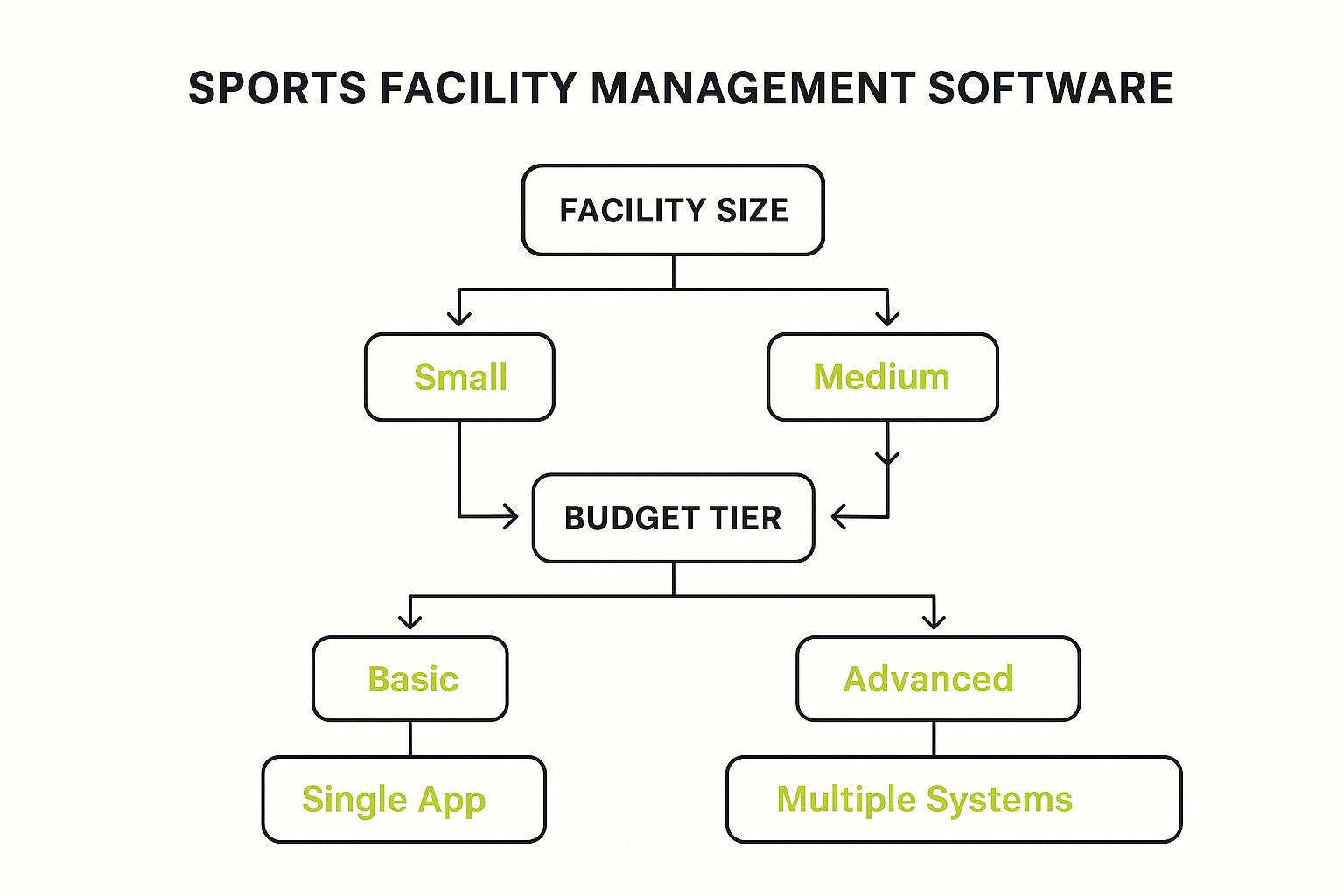
As you can see, bigger, more complex facilities often need advanced platforms that can integrate with lots of other tools, while smaller venues might be better off with a simple, all-in-one app that just works.
A Practical Checklist for Evaluating Vendors
When you start scheduling demos with software providers, you need a structured game plan. Having a set list of questions ensures you get the info you need to make a real, apples-to-apples comparison. Don't be afraid to dig in and ask the tough stuff.
This simple table is a great framework to use during your calls and demos. It keeps you focused on what really matters.
Software Selection Checklist
| Evaluation Criteria | Questions to Ask | Why It Matters |
|---|---|---|
| Onboarding & Support | What's the implementation process like? What kind of training and support do you offer after we go live? Are your support hours aligned with our business hours? | A smooth switch is everything. Great support means you get help when you need it most, cutting down on headaches and frustration for your team. |
| Pricing & Contracts | Can you give me a clear, all-inclusive price? Are there hidden fees for setup, support, or payment processing? What are the contract terms and cancellation policies? | You need to avoid budget surprises. Understanding the total cost—not just the monthly subscription—is critical for your bottom line. |
| Security & Reliability | How do you protect our member and payment data? What’s your guaranteed uptime? What’s the plan if there’s an outage? | Data security is a deal-breaker. You’re responsible for your members' information, and a reliable system is essential to keep their trust and your doors open. |
Choosing the right software is a major strategic decision that will impact your club's efficiency and profitability for years to come. Take your time, do the research, and pick a partner who truly gets the business of sports.
Getting Your New Software Up and Running Smoothly
Picking the perfect sports facility management software is a great first step, but the real win comes from a seamless launch. Think of it like building a fantastic new stadium; the design might be world-class, but it only proves its worth when the gates open and fans pour in without a hitch. A bumpy rollout can frustrate your staff and annoy your members, completely wiping out the efficiency gains you were aiming for.
A smooth transition doesn't happen by accident—it’s the result of a solid, well-thought-out game plan. This isn't just about flipping a switch. It's a careful process of moving your data over, getting your team comfortable with the new tools, and clearly communicating the changes to get your members on board and excited.
The Critical First Step: Data Migration
All that information you have—member profiles, booking history, payment details—is the lifeblood of your venue. Getting that data from the old system to the new one flawlessly is completely non-negotiable. It's like moving your entire trophy case to a new building; you can't afford to drop or lose a single piece of your club's history.
You'll want to work hand-in-hand with your software provider to make sure every last bit of information is transferred correctly. This involves mapping old data fields to the new ones and running plenty of tests to be certain everything looks right. A clean data migration saves you from future nightmares, like members calling because their court credits have vanished or their contact info is all wrong.
Empowering Your Team with Great Training
Your staff are the ones who will be using this new tech every single day. If they aren’t confident with the software, they can’t deliver the top-notch service your members expect. That's why thorough training is so important—it turns your team into the biggest fans of the new system.
A solid training plan should always include:
- Hands-On Practice: Let your staff play around in a test environment. Have them practice everyday tasks like making bookings, processing payments, and updating member profiles.
- Role-Specific Training: Your front-desk crew needs a different skill set than your back-office finance team. Make sure the training is tailored to what each person actually does.
- Ongoing Help: Don't just train them and leave them. Provide cheat sheets, short video tutorials, and a go-to person for any questions that pop up after launch day.
This investment in training pays for itself almost instantly. When your team is comfortable with the platform, they can handle small issues on their own and show off the software's benefits to members with real confidence.
Bringing Your Members Along for the Ride
Finally, you need to get your members excited about the change. A sudden switch with no explanation can cause confusion and pushback, even if the new system is miles better than the old one. Smart, positive communication is the key to getting members to embrace the new system right away.
Frame the switch as a direct win for them. This isn't just "new software." It's their new way to get instant court bookings, manage their membership from their phone, and have a better all-around experience at your club.
Start talking about the change weeks before it happens. Use emails, social media, and even posters at your club to announce what's coming. Highlight the cool new features, like a mobile booking app or an automated waitlist for popular times. The more you explain why you're making the switch, the more your members will get behind it.
For anyone planning a new club, getting these operational details right is just as crucial as the initial build-out. You can learn more about key considerations for opening a padel venue in our detailed guide. A well-managed software launch ensures your facility runs like a well-oiled machine from the moment you open your doors.
Maximizing Your Return on Investment
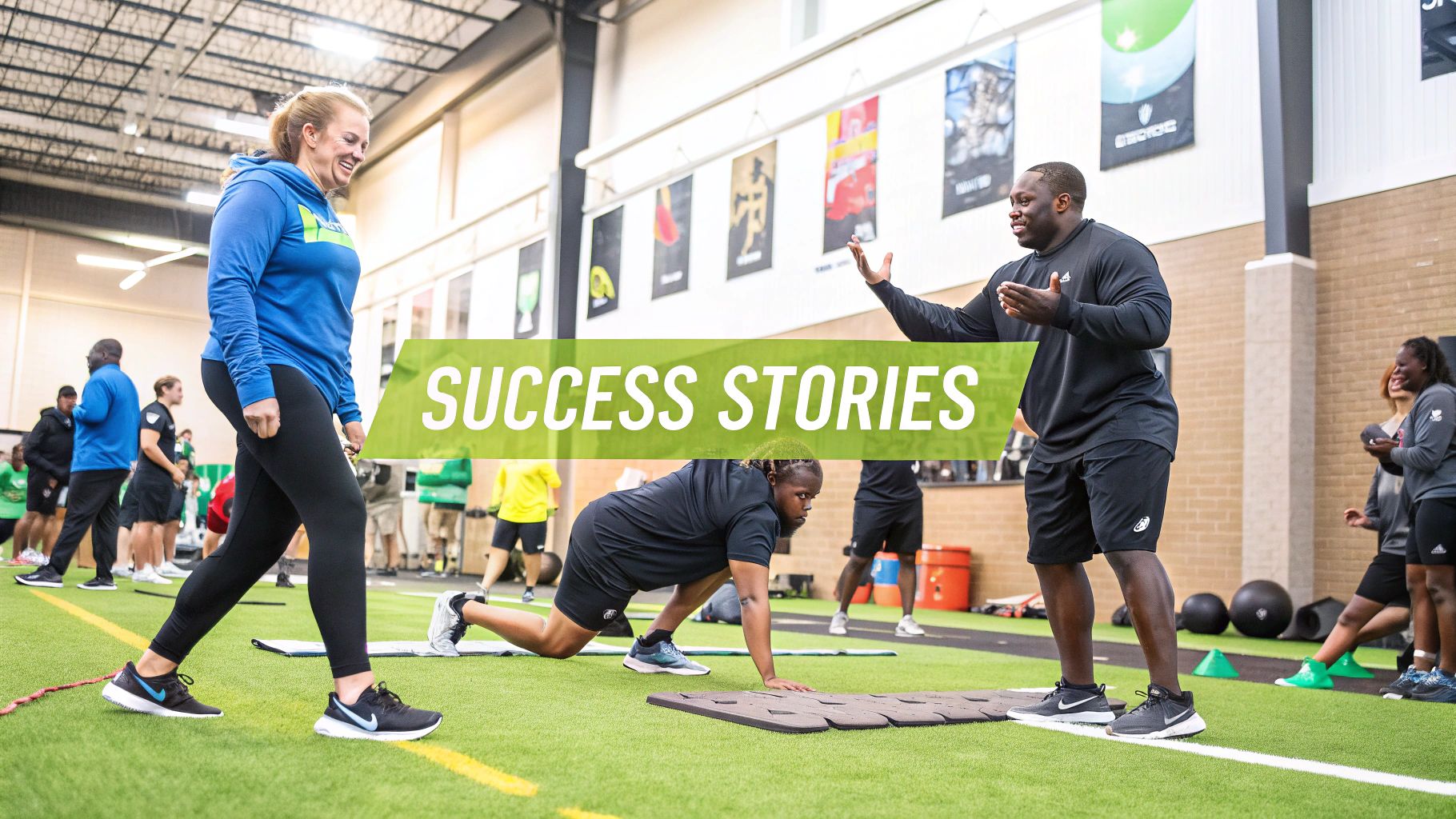
Your sports facility management software shouldn't just be another line item on the expense sheet—it needs to be a powerful investment. The real goal here is to turn this technology into a profit center that actively fuels your facility's growth. To truly maximize your return on investment (ROI), you have to look beyond the basic features and use the platform's full toolkit to both generate new income and slash existing costs.
Think of your software like a high-performance engine. You can use it to just get from A to B, or you can fine-tune it to win the race. It's all about unlocking its full potential to drive financial success and build long-term stability for your venue.
Creating New Revenue Streams
One of the most direct ways to boost ROI is by using your software to open up fresh revenue opportunities. Instead of treating court bookings as a simple, fixed-price commodity, your platform can introduce smarter pricing strategies that react directly to player demand. This approach ensures you're always optimizing your income.
- Implement Dynamic Pricing: Dig into your booking data to pinpoint your most popular time slots—like those coveted weekend mornings or weekday evenings. You can then automatically bump up the price for these peak hours, making sure you capture maximum value when demand is highest.
- Launch Targeted Promotions: Got a quiet spell on Wednesday afternoons? The software lets you create and fire off a special discount code to a specific list of members who tend to play mid-week. Just like that, you turn empty court time into revenue.
- Integrate Pro Shop Sales: Connect your point-of-sale system directly to member profiles. When a player books a court, you can flash them a "bundle and save" deal on a new can of balls or a grip replacement, encouraging those valuable add-on purchases.
Unlocking Significant Cost Savings
Beyond bringing in new cash, a huge part of your ROI comes from the software's ability to drastically cut operational costs. It automates tedious administrative work and gives you the foresight to prevent expensive problems before they even happen. Many facilities see a huge drop in critical incident callouts—some by as much as 50%—simply by having better monitoring and response systems baked in.
Your software should do more than just manage your facility; it should protect your bottom line. By automating routine tasks and offering predictive insights, it transforms from a simple tool into an active cost-saving partner.
Optimizing Staff and Maintenance Expenses
The right platform also gives you powerful tools to manage your two biggest variable costs: staffing and maintenance. By analyzing historical booking data, you can build staff schedules that perfectly match your facility’s ebbs and flows, eliminating wasteful overstaffing during slow periods.
On top of that, some platforms offer predictive maintenance features. The system can track equipment usage—like court time or light usage—and send alerts when it’s time for preventative upkeep. This proactive approach helps you sidestep sudden, expensive equipment failures and extends the life of your most valuable assets, delivering a clear and measurable return on your software investment.
Common Questions Answered
Even after seeing all the benefits, jumping into the world of sports facility management software can feel like a big step. Let's tackle some of the most common questions that come up so you can move forward with confidence.
What’s the Typical Cost for Sports Facility Management Software?
The price tag can swing quite a bit, really depending on your club's size, what features you're after, and how the provider structures their pricing. For a smaller club with just the basic needs, you might find a subscription for under $100 a month. On the other hand, a large, multi-sport complex could be looking at costs upwards of $500 monthly.
But here’s the thing: it’s not just about the price, it’s about the value. If a platform costs a little more but saves your team ten hours of admin work every week and bumps up your court bookings by 20%, it's paying for itself and then some. Always get a detailed quote that’s built specifically for your club's day-to-day operations.
Can This Software Juggle Bookings for Different Sports?
You bet. That kind of versatility is exactly what modern platforms are built for. A solid system will let you set up all your different spaces—padel courts, tennis courts, maybe even a basketball court—and give each one its own booking rules, time slots, and pricing.
This is a game-changer for any facility offering more than one sport. It means that whether a member is booking a 90-minute padel match or signing up for a 60-minute tennis lesson, the whole process is smooth and the system enforces the right rules automatically. No more manual mix-ups.
How Hard Is It to Switch from Our Old System to a New One?
Making a change always takes some planning, but any software provider worth their salt will bend over backward to make the switch as painless as possible. They usually offer dedicated support and will handle the data migration for you, moving over all that crucial info like member lists and booking histories without a hitch.
A smooth transition really boils down to two things: great staff training and clear, upfront communication with your members. You'll want to partner with a software provider who has a proven track record of helping clubs get up and running.
The best companies act more like partners than just vendors. They’ll work with your team every step of the way to make sure everyone feels comfortable with the new tools from day one, avoiding all the headaches that come with a messy switch.
Ready to dive deeper into the world of padel? Here at Padel Rumors, we've got everything from expert gear reviews to the latest buzz from the pro tours. Check us out at https://padelrumors.pages.dev to level up your game and stay plugged into the sport.





